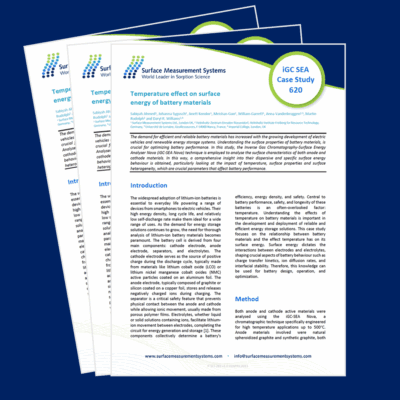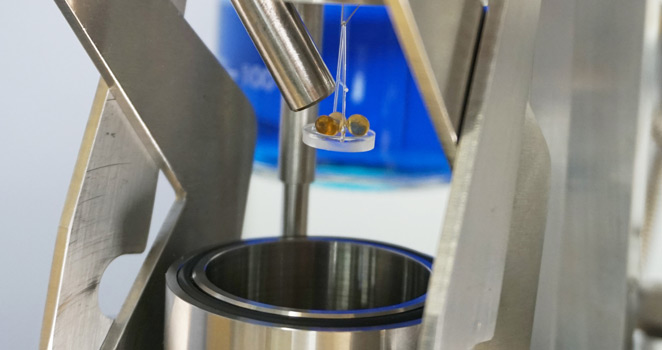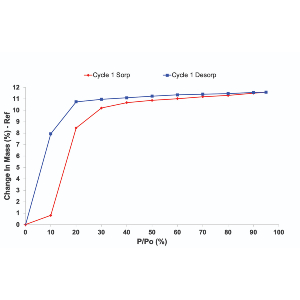
Impact of High Temperature and Humidity on Batteries:
What really happens when batteries face real-world conditions?


Impact of High Temperature and Humidity on Batteries:
What really happens when batteries face real-world conditions?

Inside the note, you’ll learn:
|
|
Why BTA Frontier?
If you’re designing sorbents, optimizing processes, or comparing materials, the right setup can save weeks of work. The BTA Frontier’s small-sample, high-sensitivity approach means you can move faster, get cleaner data, and make decisions with confidence.

Download the Technical Note Now!
Discover how the BTA Frontier delivers real-world gas and vapor adsorption insights.
Download the full technical note to explore breakthrough curves, regeneration studies, and performance data on Zeolite 13X.

2024: New starters
for the SMS Team
The team at Surface Measurement Systems continues to expand, with every office seeing new members join us for the exciting times ahead!
Below is a quick review of who has joined us in the last year.

New Team members

Impact of High Temperature and Humidity on Batteries:
What really happens when batteries face real-world conditions?


Sorption Bulletin
Best of 2024
We are happy to offer you this Sorption Bulletin, providing an overview of some of our most exciting recent publications, peer-reviewed papers, and interesting articles in the field of sorption science.
Discover the latest insights and technological advances in a range of applications.

SMS Scientific Notes
Application Note 112: Influence of humidity and temperature on the drying kinetics, phase composition and morphology of gypsum
Download a copy
Case Study 620: Temperature effect on surface energy of battery materials
Download a copy
Application Note 70: Investigating Uniformity of Dry Powder Inhalation Formulations using Vapour Sorption Techniques
Download a copy
Application Note 109: Studying Moisture Induced Transformations and Degradation of Pharmaceutical Ingredients Using Raman Spectroscopy Combined with Dynamic Vapor Sorption
Download a copy
Application Note 110: Analyzing Multicomponent Permeation Through Barrier Membranes Using the Membrane Permeation Analyzer (MPA Horizon)
Download a copy
Application Note 111: Realistically evaluating the capabilities of Zeolite 13X as a sorbent for Direct Air Capture in different scales
Download a copy
Additional Reading
Carbon Capture Storage Review 2024
Download a copy
Article: Innovative Approaches to Analysing Moisture Interactions in Pharmaceutical Materials with Dynamic Vapor Sorption (DVS)
Read here
Publications
Scientific Paper: MOF-based sensors for the detection of airborne α-pinene, RSC Appl. Interfaces 2024, 10.1039.D4LF00027
Read here
Book: Chapter 3: The Dynamic View: Multiscale Characterisation Techniques for Flexible Frameworks
The Dynamic View: Multiscale Characterisation Techniques for Flexible Frameworks | Flexible Metal–Organic Frameworks Structural Design, Synthesis and Properties
Books Gateway | Royal Society of Chemistry (rsc.org)

Across the World,
SMS’ers Celebrated the Festivities in Style!
It’s been a busy end to the year for Surface Measurement Systems, with a huge push in instrument sales, Production sending products flying out the door, and Sales still hitting the road to drum up those last bits of busy!
Somehow, we’ve still found time across the world to celebrate our festive seasons as a team! From Diwali in Hyderabad to Christmas in London, the Global SMS Team celebrated the festivities in style!

SMS India & PCL Celebrate Diwali
| The SMS India & PCL Team held a special event to celebrate the five-day Diwali Festival. Marking the Hindu New Year, Diwali symbolizing new beginnings and the triumph of good over evil. Also known as the Festival of Lights, Diwali is celebrated through the sharing of meals and sweets, decorating with oil lamps called “diyas”, making colorful patterns on the floor called rangoli (see below), and setting off fireworks. Hopefully, this last activity was done outside of the office.
Happy Diwali to all our Hindu colleagues in Hyderabad, and around the world! |
SMS UK Toast Christmas at Pub Party
| The team from Surface Measurement Systems London got in the Festive spirit with a company lunch at the Defector’s Weld Pub in Shepherd’s Bush. Following a hearty meal, company Founder & MD, assumed the sacred duty of handing out Secret Santa gifts to all members of staff. |

SMSNA Saving the Best for Last
Not to be outdone, our colleagues at SMSNA are saving their best for last, having their Christmas Staff Meal later this week! We wish them a happy Season’s Greetings, and hope they have a great day celebrating the festive season!

Carbon Capture
Sorption Science Pack
Download Free Now
Surface Measurement Systems have been pioneering sorption-based solutions Carbon Capture, developing groundbreaking new instruments that enable analysis and insights never possible before.
Please download this free pack of recent scientific publications on Carbon Capture Applications of sorption science, including recent case studies and scientific overviews. If you have any questions about the topics explored, please do stop by our stand at AiCHE 2024.
Expanding the Senior Leadership Team:
Driving the Future of
Surface Measurement Systems
Surface Measurement Systems Holding LLC and its subsidiaries are entering an exciting new chapter, marked by growth, innovation, and an ambitious vision for the future. To support this next phase, we have expanded our Senior Leadership Team, ensuring we have the expertise and leadership needed to meet our goals.
This expansion includes elevating talented team members and welcoming new leaders, bringing fresh perspectives and expertise. With this enhanced team in place, SMS is better equipped than ever to drive innovation, seize emerging business opportunities, and continue improving our solutions to meet the evolving needs of our customers.
The future of Surface Measurement Systems is bright, and this leadership expansion reflects our commitment to staying at the forefront of sorption innovation, delivering exceptional value and results.

Senior Leadership Team

Europe & US Symposiums bring leading sorption scientist together
2024 saw a grand return for the live editions of the Sorption Symposium Series. With the 202 Pandemic scuppering plans for a live scientific event in 2020, Surface Measurement Systems were thrilled to be able to bring the event back to the face-to-face format, enabling a shared learning and networking experience for sorption scientists from around the world.
Eager to offer an in-person return to our users and peers around the world, the Sorption Symposium saw two live events held this year. The first, taking place in May, was held at the New Jersey Institute of Technology, while the second returned to the venue we had to cancel in 2020, University of Vienna, for our European symposium in September.

Sorption Symposium North America 2024 (7 – 9 May)
Gathers Leading Sorption Experts in New Jersey
Gathers Leading Sorption Experts in New Jersey
| The Sorption Symposium North America 2024, organized by Surface Measurement Systems, recently concluded with great success, showcasing the latest advancements in sorption science. Held in Allentown, PA, the event attracted over 60 attendees from various industries, including pharmaceuticals, environmental sciences, and material engineering. It offered a rich program featuring renowned speakers such as Dr. Maria Krisch from FreeThink Technologies and Dr. Neeraj Borker from 3M. Their presentations, alongside other experts, covered critical topics in sorption behavior, moisture analysis, and its applications across diverse fields.
A highlight of the event was the strong participation in the hands-on training sessions, where attendees received practical insights and guidance from an expert panel. The training provided an interactive platform for participants to deepen their understanding of dynamic vapor sorption (DVS) technology and its role in enhancing material performance, stability, and formulation development. This engaging format fostered an environment of collaboration and learning, elevating the educational value of the symposium. The symposium also created ample opportunities for networking, particularly during the on-site Networking Party. Attendees had the chance to connect with peers, exchange ideas, and explore potential collaborations, further strengthening the event’s impact. Overall, the Sorption Symposium North America 2024 was a resounding success, bringing together a diverse group of professionals to share knowledge, engage in hands-on experiences, and build relationships within the sorption science community. |
|
 |
 |
 |
 |
University of Vienna Plays Host to
Sorption Symposium Europe 2024 (18 – 20th Sept)
Sorption Symposium Europe 2024 (18 – 20th Sept)
|
The Sorption Symposium Europe 2024, hosted by Surface Measurement Systems, was a resounding success, gathering over 70 attendees at the University of Vienna from September 18-20. This premier event brought together leading minds from academia and industry to explore cutting-edge advancements in sorption science, particularly focusing on Dynamic Vapor Sorption (DVS) and Inverse Gas Chromatography (iGC), and recent developments in Carbon Capture Sorption Analysis capabilities. The symposium featured a stellar lineup of speakers, including Dr. Daniel Burnett and Dr. Anett Kondor from Surface Measurement Systems, along with global experts like Dr. Neeraj Borker (3M), Prof. Peter Budd (UManchester), Dr. Sam Zelinka (U.S. Forest Service), and many more. These presentations covered a broad spectrum of applications in pharmaceuticals, carbon capture, and material science, offering a comprehensive look at current research and future potential. Day three saw strong participation in hands-on workshops, where attendees received in-depth training on advanced sorption instruments, gaining valuable skills from global experts. In addition to the academic content, attendees enjoyed vibrant networking events, which included a wine and beer tasting, a traditional Austrian meal, and a unique ‘Hidden Vienna’ tour. These activities allowed participants to form lasting professional relationships in a relaxed atmosphere, enhancing the collaborative spirit of the symposium. |
|
 |
 |
 |
 |

2024: New starters
for the SMS Team
The team at Surface Measurement Systems continues to expand, with every office seeing new members join us for the exciting times ahead!
Below is a quick review of who has joined us in the last year.







































